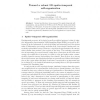14 search results - page 1 / 3 » Learning cortical topography from spatiotemporal stimuli |
72
Voted
BC
2000
15 years 7 days ago
2000
Abstract. Stimulus representation is a functional interpretation of early sensory cortices. Early sensory cortices are subject to stimulus-induced modi
108
Voted
JCNS
2002
15 years 2 days ago
2002
We present a reduction of a large-scale network model of visual cortex developed by McLaughlin, Shapley, Shelley, and Wielaard. The reduction is from many integrate-and-fire neuron...
ICASSP
2011
IEEE
14 years 4 months ago
2011
IEEE
Cortical recordings with high temporal resolution enable the tracking of neuronal excitation in response to stimuli. Here intra and extracranial recordings are analyzed from exper...
ESANN
2007
15 years 1 months ago
2007
Abstract. Several models have been proposed for spatio-temporal selforganization, among which the TOM model by Wiemer [1] is particularly promising. In this paper, we propose to ad...
NIPS
2003
15 years 1 months ago
2003
We report and compare the performance of different learning algorithms based on data from cortical recordings. The task is to predict the orientation of visual stimuli from the ac...

